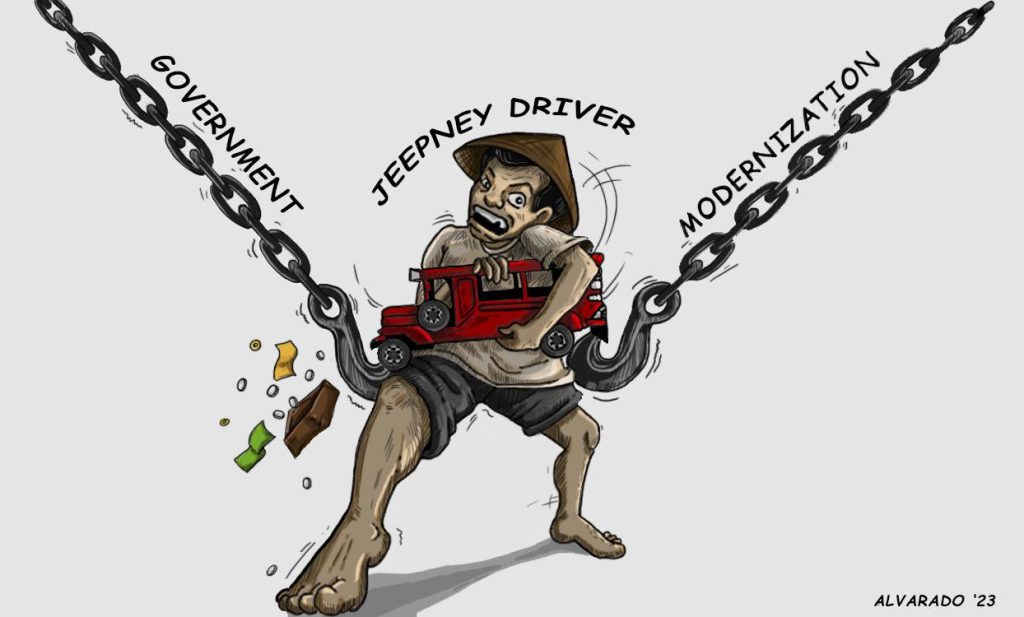
By Noli Cajes
For decades since the second world war, the traditional jeepneys have been an iconic cultural symbol on Philippine roads as it blazes through with their flamboyant designs while every painting showcases a rich and diverse heritage. It reigned the kingdom of the Philippine roads as it stretched its prominence as the primary transportation modality of the Filipino people. However, behind its momentum lies a harbinger of danger signaling as the government attempts to put a red light as it eyed to enforce its anti-poor transport policy, the Public Utility Vehicle Modernization Program (PUVMP). Now, this issue has two sides, just like how the traditional Jeepney has the driver’s seat and the long passenger seats at the back. The seats at the back are for Filipinos who will benefit from this implementation. However, the driver’s seat is left with nothing but the harsh transition of modernization.
The traditional jeepney has been a staple of transportation not just in Panabo but all over the Philippines, serving students and blue-collar workers while providing a livelihood for drivers who may not have other means to support their families. However, since June 2020, the Land Transportation Franchising and Regulatory Board (LTFRB) has been campaigning for a jeepney phaseout to promote a more sustainable, efficient, and eco-friendly way of transportation. Recently, the LFTRB has extended the deadline to the end of the year instead of the initial plan this April. Still, the Pinagkaisang Samahan ng mga Tsuper at Operator Nationwide (PISTON) only declares this a small victory. The fight is far from over as they continue to protest for an end to PUVMP.
The main reason for opposition to modern jeepneys, which are meant to be an alternative to traditional ones, is their high cost. The typical jeepney driver earns around P500 to P600 per day, but their income may decrease due to rising gas prices and inflation. Modern jeepneys are considered a luxury as they cost between P2.4 million and P2.8 million per unit, which is unaffordable for most drivers. To help the drivers, the government has offered an equity subsidy of P160,000, which only covers less than 8% of the total cost. This shows that the plan to phase out traditional jeepneys is biased against the poor, and it is important to look at the numbers to understand why.
Moreover, the effect this plan will have on jeepney drivers for the reason that drivers do not exactly get the most eye-catching pay, and a majority of them are struggling with it; adding this plan will be burdensome. According to Rappler, the operation transport entities are viable if the cost is between P1.6 million and P1.8 million per unit. “The viability is now questionable,” LandBank assistant Vice President Generoso David stated during a hearing conducted by the House Committee on Transportation. The price in itself can cause the drivers to be slaves to a never-ending payment process, working them to the bone and not being able to properly provide for themselves.
Furthermore, this implementation of modernization will also affect the everyday civilian who uses public transportation as means of going anywhere they need to be. A recent study by the University of the Philippines estimated minimum jeepney fares could rise by 300% as a result of PUVMP. The study warned of two blind sides: the high price per unit of the modern jeepney and the domino effect of a possible jeepney fare hike to cover the cost of purchasing modern jeepney units. If this will be implemented and finalized, the prices of transportation would be a monstrosity to deal with for any individual.
Looking at it from a perspective outside of economics, eliminating local jeepneys would deprive us of a distinct cultural characteristic. Despite originating as a form of public transportation, it has evolved to become a powerful symbol of our nation’s identity. The brightly painted vehicles were the product of Filipino ingenuity, repurposing old jeeps abandoned by the US army into mini-buses capable of carrying up to 25 passengers after World War II. Removing them would be tantamount to erasing a vital part of our culture.
While PUVMP has admirable goals, it is important to recognize that in a country where poverty is prevalent, ideals must not overpower reality. Although it is important for the public to have access to efficient and affordable transportation, large-scale programs that affect the lives of many individuals should be carefully planned and executed. Before deciding to phase out jeepneys, a thorough assessment of the costs and benefits should be conducted. Such a plan must consider the impact on commuters, drivers, and operators, as well as the environmental and safety concerns associated with these vehicles. Additionally, alternative transportation options and job opportunities for those affected by the transition should be provided.
In summary, as modernity and globalization continue to thrive in the status quo, and as a country endeavoring for a more competitive economy to meet global standards, modernizing PUVs may solve societal problems including that of environment and security. However, in order to adapt to the ever-changing times, the impact of these changes in utilities on the lives of millions must be thoroughly taken into consideration and the government should provide proper mechanisms for traditional jeepney drivers. Otherwise, both the passenger seat and the driver seat will fall into great affliction. Now, it is time for the government to put a red light on their incompetence.


